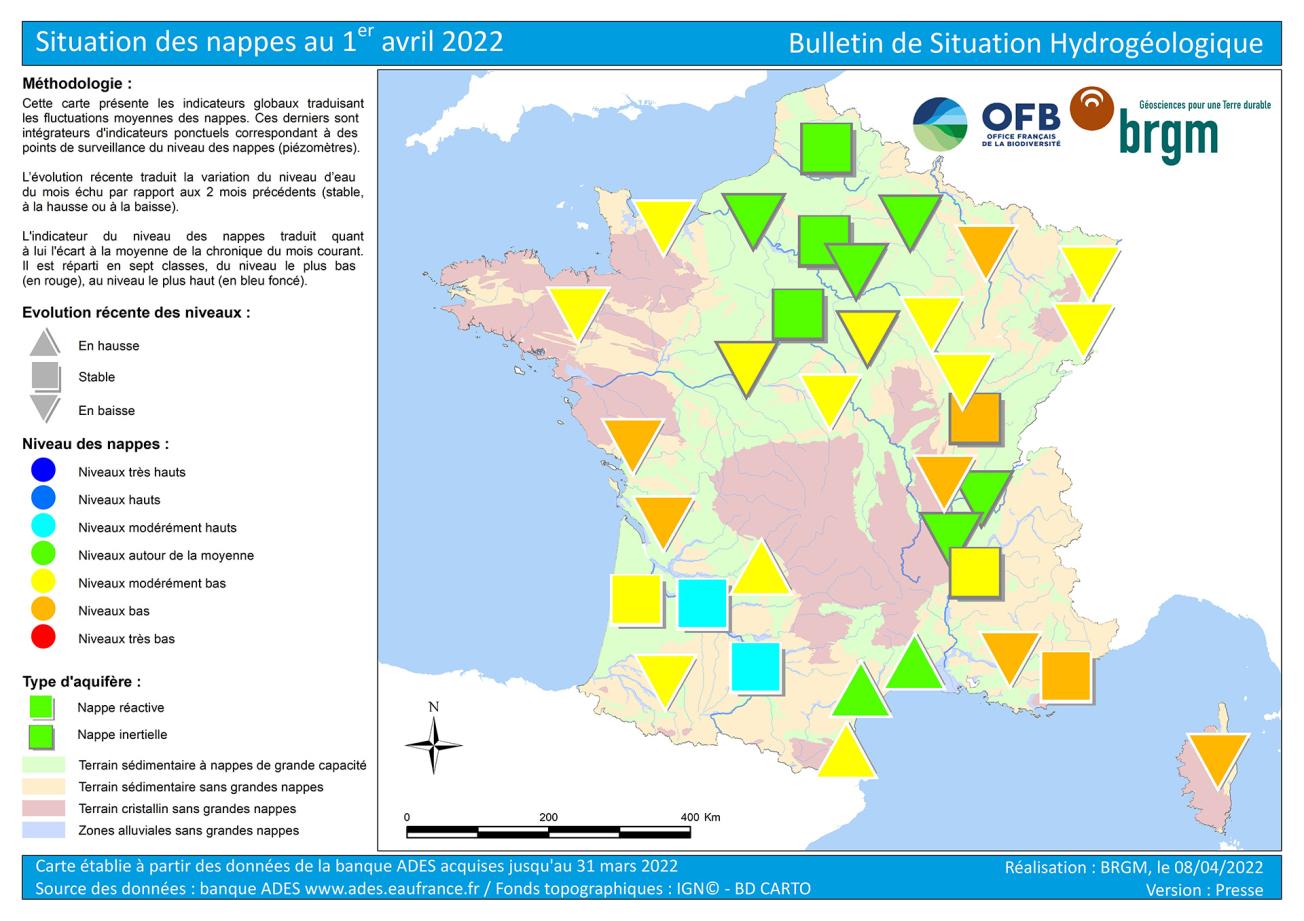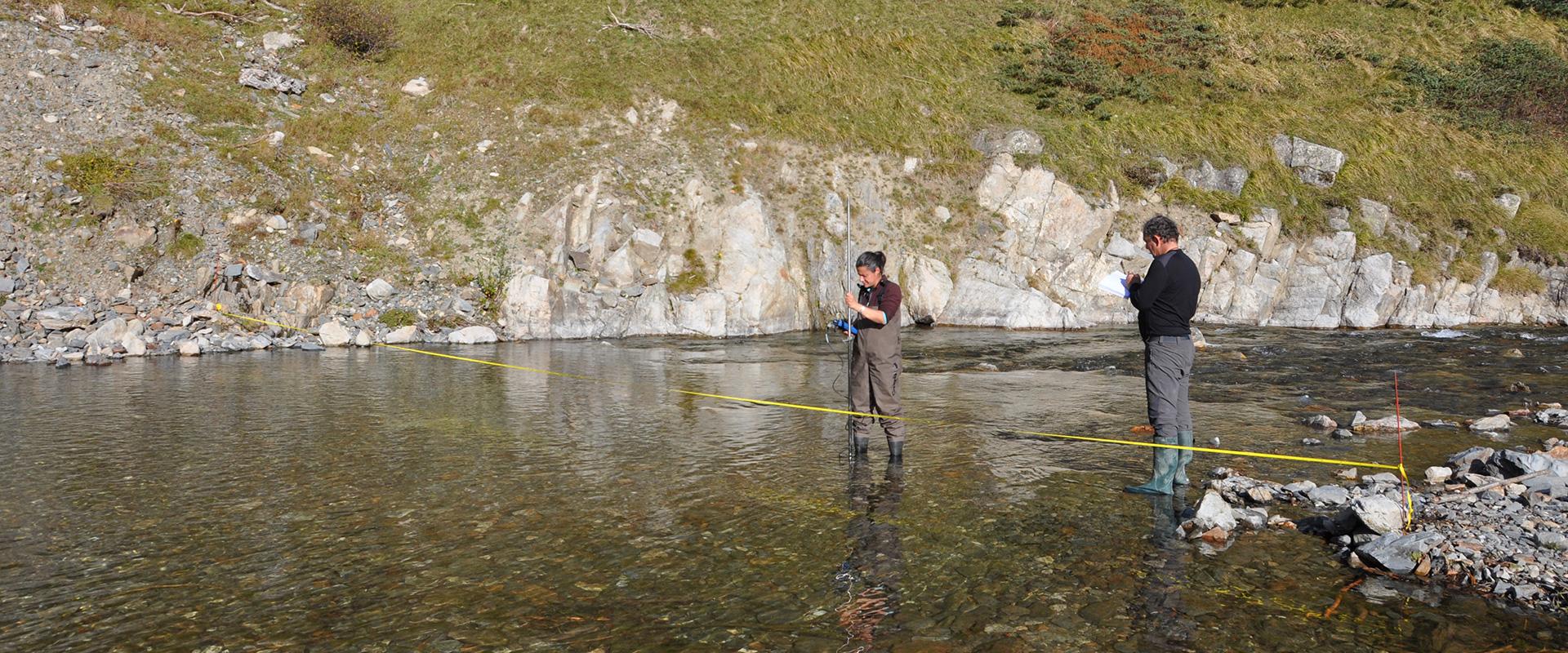
Map of groundwater table levels in France on 1 April 2022.
© BRGM
Hydrogeological situation on 1 April 2022
The depletion period began in February, two to three months earlier than normal. In March, aquifer levels were generally dropping. Only the most inertial aquifers, whose levels remained stable, were still benefiting from the slow infiltration of winter rainfall. Recent effective rainfall in the south enabled certain aquifers to recharge and levels there were either stable or rising.
While the low water period in autumn 2021 was not particularly severe, the situation deteriorated rapidly in February and March 2022. The end of winter is a pivotal period and the lack of rainfall this year had a strong impact on the state of the aquifers. The situation is particularly worrying in the aquifers in Vendée, Périgord and Maine, as well as in Provence and the Côte d'Azur.
Unless there is extremely strong rainfall in April, the aquifer levels should continue their downward trend. The situation in inertial aquifers is not expected to change much in the next few weeks. The situation in reactive aquifers will depend on the amount of rainfall. In the event of insufficient rainfall, the depletion of the aquifers could continue, and the state of the reactive aquifers would therefore further deteriorate. The situation needs to be closely monitored in all the reactive aquifers as well as in inertial aquifers which currently have low water levels, or in areas where withdrawals are particularly intensive.
Groundwater trends
The 2021-2022 recharge period was short and not very dynamic in all the aquifers. The aquifer depletion phase progressively commenced as of February 2022, since there was an overall lack of effective rainfall and vegetation started growing back. During March, the trends were variable, depending on the local rainfall and the inertia of the aquifers.
In the northern two-thirds of the country, the depletion of all the aquifers continued. The levels in reactive aquifers have been decreasing since February, due to a lack of significant effective rainfall. The trends in inertial aquifers started to reverse in March, with levels generally falling. Nonetheless, the recharge continued, albeit very slowly, in the most inertial aquifers of the Paris Basin and in the Rhône-Saône corridor. Levels stabilised during the month of March, since the rainfall of the previous few months slowly filtered through to the aquifers.
In the south, trends were mixed, depending mainly on effective local rainfall. In the Aquitaine Basin, there was sufficient rain to recharge the aquifers in certain areas, notably in the karstic limestone aquifers of the Causses. In the south-east, the aquifers in Roussillon, Languedoc and in the regions around Montpellier and Nîmes benefited from the significant recent rainfall and levels were rising. The levels in the aquifers in Provence and Côte d'Azur were either dropping or stable. The early snowmelt or localised rainfall resulted in a slight recharge. Finally, the alluvial aquifers in Corsica suffered from the lack of rainfall over recent months and their levels have continued to drop since February.
Situation in relation to March averages
The majority of the aquifers across France did not experience a particularly severe low-water period in 2021, except in the south of the country. The rainfall at the beginning of the recharge period helped maintain a generally satisfactory situation until January 2022. In February and March, the lack of significant recharge episodes affected the state of the aquifers. The overall situation of the aquifers deteriorated slowly during March, apart from around the eastern Mediterranean coast, which received a lot of rain.
In March, reactive aquifer levels were generally lower than normal for the month, ranging from moderately low to low. Only a few aquifers in the south of France had above-normal levels. Locally, very low levels were noted in the Cenomanian sand aquifer in Maine, in the Jurassic limestone and Cretaceous aquifers in Vendée, Périgord and in the Angoumois basin, as well as in aquifers in Provence and the Côte d'Azur.
As regards the inertial aquifers in the north of France, the situation has deteriorated slightly since February. Levels remained satisfactory, ranging from average to moderately Low. The situation in the inertial aquifers in the Rhône-Saône corridor was varied and less positive, with levels ranging from being close to monthly averages to low.
The situation is positive in several aquifers, with moderately high to approximately normal levels compared to those recorded in March in previous years:
- The levels of the inertial aquifers in the centre and the north of the Paris Basin are comparable to those normally observed and the recharge is coming to an end;
- The alluvial aquifers in the upstream area of La Garonne and its main tributaries did not experience a particularly severe low-water period and benefited from several recharge episodes during the winter. Consequently, their levels remained moderately high;
- The alluvial aquifers along the Languedoc coast and the karstic limestone aquifers in the Montpellier and Nîmes regions benefited from effective rainfall in March and their levels were relatively normal.
A less positive situation was observed in certain aquifers, whose levels were moderately low (or even low to very low, in some areas) compared to March averages:
- The levels in the Cretaceous limestone aquifers in Périgord and the Angoumois basin ranged from low to very low on several piezometers, since the recharge period started late and did not last long;
- The levels of the Plio-Quaternary gravel inertial aquifer in Bourgogne-Franche-Comté and in the reactive alluvial aquifers of the upper Rhône and Saône were low, due to a poor recharge;
- The levels of the complex and alluvial aquifers in Corsica, Provence and the Côte d'Azur were low, due to poor recharges in 2020-2021 and 2021-2022. The alluvial aquifers of the Côte d'Azur coastline seem to have already reached their maximum annual levels.
Forecasts
Météo-France's forecasts are hardly optimistic as regards the aquifer situation: from April to June 2022, the forecasts are for warmer and drier-than-normal weather. However, oceanic disturbances could extend across France. The rise in temperatures, the regrowth of vegetation and therefore the increase in evapotranspiration will clearly reduce the amount of rainfall that filters through to the aquifers. The early start of irrigation campaigns could also influence the situation of the aquifers.
In reactive aquifers, the trends for the month of April will depend on the combined effects of rainfall, evapotranspiration and/or vegetation regrowth. If there is sufficient rainfall, the depletion of the aquifers could continue or resume, depending on the area. In this case, the state of the aquifers would continue to deteriorate. The recharge could nevertheless resume in areas that receive a lot of rainfall, meaning the situation might then improve. From April onwards, recharge episodes will probably be occasional and not particularly intense, unless there are exceptional episodes of rainfall.
In April, we expect to see confirmation that the depletion period has begun in all the inertial aquifers. The downward trend in levels should continue until the autumn, and the situations are expected to deteriorate very gradually during the spring and summer. In April, the situations should remain similar to those observed in March.
This year's recharge has been very short (November to January) and quite moderate across most of the aquifers, suggesting that the situation will become difficult from spring onwards. The situation needs to be closely monitored in all the reactive aquifers, in particular in the Cenomanian sand aquifer in Maine, in the limestone aquifers in the north of the Aquitaine Basin, and in the limestone aquifers of Lorraine, as well as in the aquifers in the south-east of France, which remain in a vulnerable state due to the fairly severe low-water period last summer. The inertial Plio-Quaternary gravel aquifer in Bourgogne-Franche-Comté also needs to be closely monitored.
Hydrological Status Report
The national hydrological status report consists of a set of maps with corresponding comments that show the monthly evolution of water resources. It describes the quantitative situation of aquatic environments (effective rainfall, river discharge, groundwater table levels, reservoir-dam filling status) and provides summary information on Prefectoral Orders issued to limit water use during the low-water period.
Press contact








